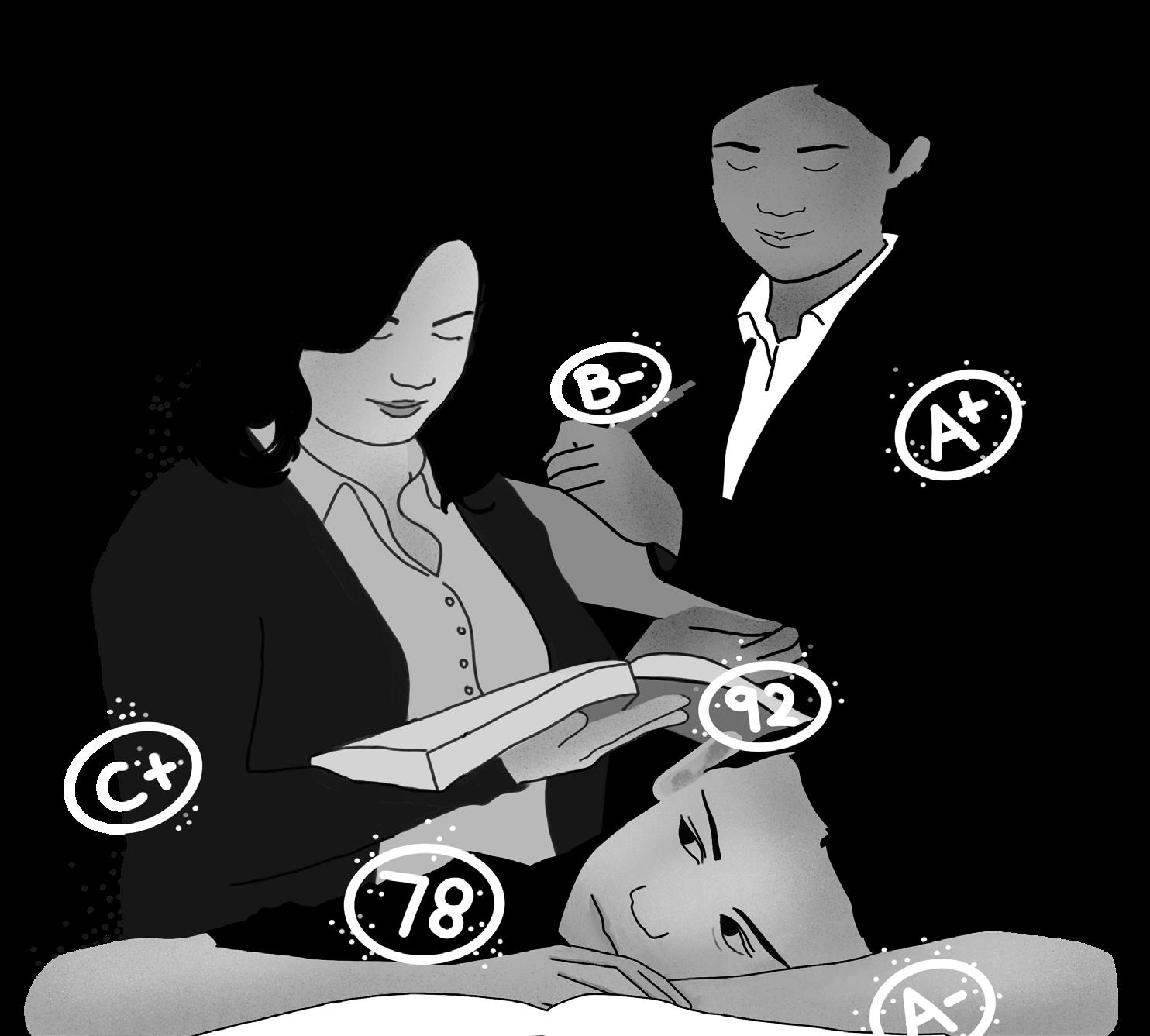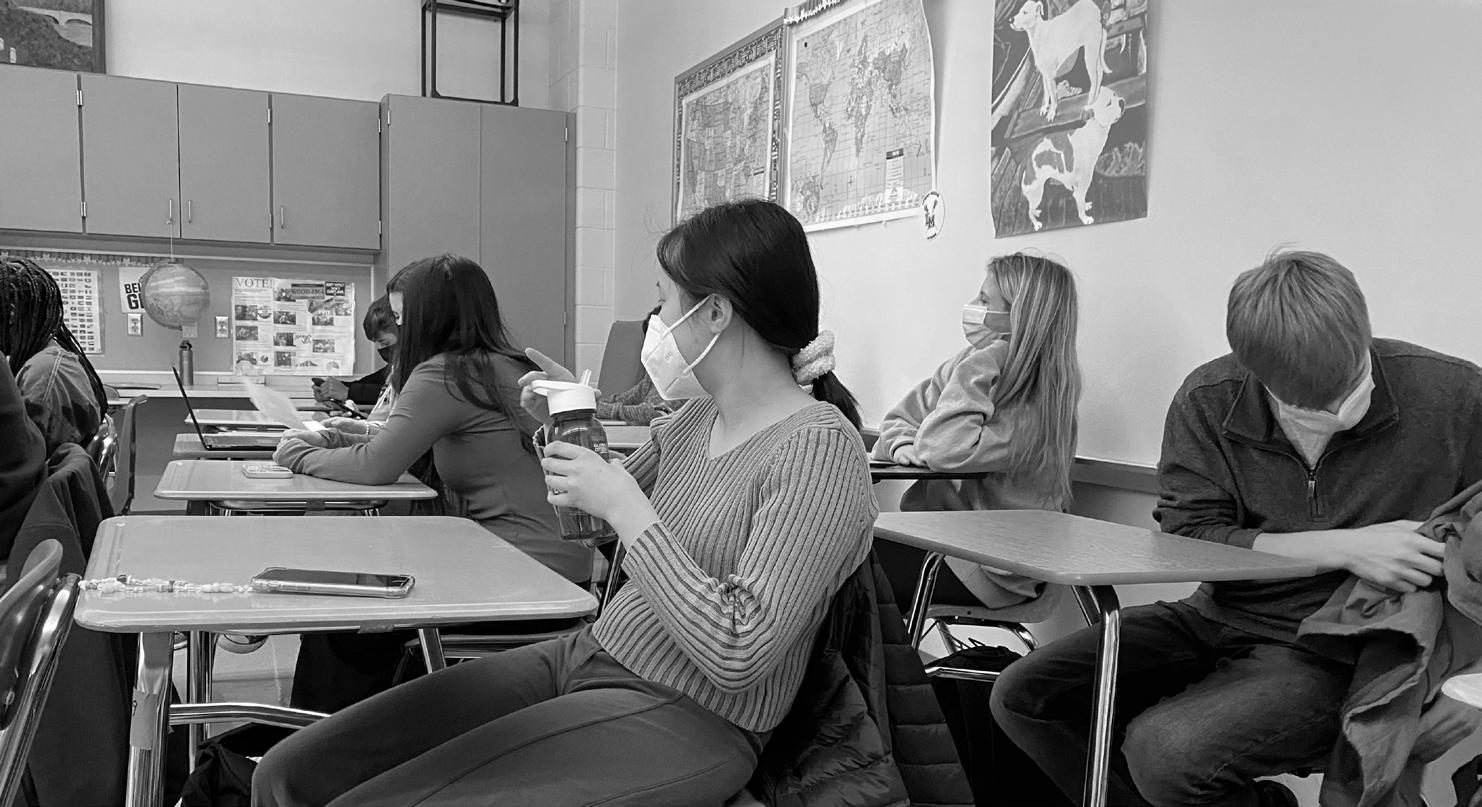
27 minute read
Please see SCHOOL LOADING... on
The Merionite Teachers get grades, too
Luke Shepard ’24 Sports Editor
Advertisement
The proper method for assessing teachers accurately has plagued school districts for years. Teachers often adjust lessons during evaluations- which makes fnding how teachers actually instruct their classes without a supervisor’s presence is near impossible. If an administrator stops by a classroom, especially during a scheduled visit, teachers can easily showcase their best teaching practices for the hour. They can reach far into their mind to bring out the best facts, jokes, and examples that make their classroom seem like a nurturing learning environment. However, it is hard to know whether or not that is actually how the teacher spends most of their class time. While standardized tests can account for what a teacher has taught their students, test scores can vary among students based on their diferent work ethics, drives, and test-taking abilities. Student reviews can help to form an opinion on a teacher's performance, but these evaluations may be flled with inaccurate assessments based on opinions on the grade they may have received. The many outlets each have their own small benefts, but the inefective issues creep in with every method. A new, state-approved form encapsulates more than just a standard check into the teacher’s performance and draws from many diferent types of reviews. The PA-ETEP, created by EduLink, is a comprehensive review of a teacher’s entire skills from many diferent sources. In an efort to combat the problems that plague districts who simply assess teacher’s based on administrative check-ins, the PA-ETEP system collects many diferent bits of information to draw a review of the teacher. The diferent categories include Walkthrough and Anecdotal Notes, the ability to store Attachments, Dynamic Reports, Principal Performance Goals (PPG), and Formal Observations with 82/13 Rating Forms. These individual categories contribute to the overall assessment of the teacher. Formal Observations are similar to the traditional method for assessing teachers as they involve an administrator arriving at a classroom and reporting on teachers’ behavior and lessons. However, the Walkthrough and Anecdotal Notes piece attempts to combat the issue of the planned visit. Walkthroughs include the tiny pieces of information on teacher’s professionalism, while Anecdotal Notes include comments from an educator regarding their own behavior and teaching. Teachers are also able to respond to the feedback that they receive on the site to refect on how they can improve. The Principal Performance Goals (PPG) section of the review makes it much easier for principals and other administrators to examine how well their ideas are implemented in their schools and districts. This section of the evaluation examines if teachers are following supervisor directions and rules in their classroom, giving administrators an idea of how their policies are being distributed throughout the school. Ultimately, all of the information that was compiled from the many diferent platforms is summed up in the Act 82/13 Rating Form with a fnal score. The goal of this fnal form is to simply have a summative rating for the teacher with all of the evidence readily available. Teachers are given a rating of either Distinguished, Profcient, Needs Improvement, Failing, or a separate rating category of Unsatisfactory or Satisfactory. The fnal form simply serves as a summative review of the
Graphic by Emmi Wu ’23/Staf
teacher. Administrators popping in on teachers can serve like safari cameramen in the middle of the Serengeti, as the interactions are never fully original. The PAETEP system tries to curb the issue by drawing from a wide range of settings in order to determine whether students are getting the most out of their time in class. Implementing this system in LMSD could allow the district to draw accurate conclusions on the performance of teachers. It captures a wide range of information based on teacher performance and could help the district to single out which teachers are performing exceptionally and which are not meeting district expectations. The new program could ensure that teachers who are given long-term employment are qualifed for their positions, especially before providing teachers with any tenure. The PA-ETEP system aims to guarantee that LM teachers are efectively instructing their classes and benefting their students’ education.
School loading...
Continued from SCHOOL LOADING... on page 1
Penn Wynne Elementary School and Gladwyne Elementary School will feed into the new middle school because, according to the LMSD website, Black Rock “is in the catchment for GES, so it will be the closest school for those students. All PWES students are already bused to middle school so busing to the new school will not be a major change. The other four elementary schools have students in the walk zones for BCMS or WVMS. It is most efcient to avoid busing students to a farther school when they could walk to a closer one.” Additionally, the website explains that studies have shown that long commutes for students on the bus increases socializing, relaxation, and more. As for the sports felds at Black Rock, there will be of-site felds, but they will most likely not be ready in time for opening. In the meantime, the new middle school will use other locations, such as other LMSD schools, in order to conduct sports practices.
After the tragic loss of LM’s principal, Sean Hughes, a petition on Change.org was created to rename the new middle school “Sean Hughes Memorial Middle School” in honor of his dedication and hard work to make LMSD a better place. However, district policy explicitly prohibits naming buildings after people. According to Buckman, the school board and administration will “work with the Hughes family and with students to create an appropriate way to memorialize Mr. Hughes as the dedicated high-school educator … he was.”
A mascot was recently chosen to represent the school by Mrs. Stout along with a group of student ambassadors. According to Black Rock’s most recent newsletter, they decided upon the Royals, the school colors being black and gold with purple accents. The students said the nickname refects qualities including strength, being welcoming to all, being smart, and being spectacular. They also liked that their mascot goes well thematically with the Bala Cynwyd Knights and the Welsh Valley Dragons. Mrs. Stout will soon begin work with a designer to create the ofcial Royals logo, after which items such as athletic uniforms and school gear can be ordered.
Featured in a video tour of the school on the LMSD website, student ambassadors reveal their excitement to attend Black Rock, as the tour of the building has exceeded their expectations. Multiple students explained how they liked the small “nests” or rooms that bump out of the sides of the building. These spaces will be used for collaborating on projects. One student in the video is looking forward to all of the books in the two story library. The recent newsletter goes more in-depth on the “‘gathering stairs,’ dining hall, courtyard, auditorium, library and gymnasium spaces, and the fexible ‘learning communities,’ where teams of students can gather in large labs and classrooms.” The recruitment for teachers at Black Rock has been ongoing. The school states that “Human Resources is keeping ‘an eye toward increasing diversity among all the schools’ excellent staf, so that every student sees adults in their building with whom they can identify. This is a complex process, but all of the principals and district administrators are committed to working together to create the best outcome for students.” As far as scheduling goes, “The 5-8 Committee has been reviewing several options for middle school schedules, which may be diferent for the ‘Lower House’ (grades 5/6) and the ‘Upper House’ (grades 7/8).” In addition, students will have the option of taking Spanish, French, or Latin starting in 5th grade. Black Rock explains how this will cause students to “end up with more minutes of world language instruction by the end of 8th grade than they have under the current program.” This will allow for students to begin at Level 3 of their language at the start of high school. In the news and announcements on the LMSD website, it explains how the “FLES program (where students are only getting one period of language per week) will be discontinued in grades 1-3 in favor of an exploratory language year in Grade 4, where students will be exposed to Latin, French and Spanish.” Due to issues involving rites of passages from the combination of ffth through eighth grade students, unlike the present sixth to eighth grade model, Black Rock assures parents and students that “Both the K-4 and 5-8 committees have subcommittees that are working on how rites of passage such as promotion ceremonies, traditional 5th-grade activities and end-of-year celebrations, will change.” Additionally, “Some events/activities may move with 5th graders to middle school and some may become 4th grade activities, depending on what is developmentally appropriate.”In the fall of 2022, Black Rock Middle School will welcome in its frst class of students, many of whom will eventually attend LMHS.
Graphic by Kayla Bogui ’23

Policies to protect
Vivian Collins ’24 Copy Editor

Photo by Aiko Palaypayon ’23/Staff
LM schools are continuing to enforce masking mandates in classrooms.
The LMSD community has done a lot in the past two years to ensure the safety of students and staf. This includes virtual and hybrid learning, shorter class periods, up and down designated staircases, and even separate lunch periods. But despite the district’s best eforts, positive COVID-19 cases continue to rise. While the case numbers are rising, so are the vaccination rates. Per CDC recommendations, everyone over the age of fve should get vaccinated and those who are eligible should get their booster dose. Over the course of the past two months, COVID-19 cases within the district have hit an all time high. As of January 31, according to the LMSD COVID-19 Dashboard, the total number of reported cases is 1,440 (1,114 student cases and 326 staf cases). LM currently has the highest number of reported cases at 144, followed by BCMS at 111. Cynwyd Elementary School has the least number of cases at 33. From September 2021 to now, the number of reported cases in the district has increased by 3248.84 percent. The COVID-19 Dashboard also lists the vaccination rates for the district by grade level. As of December 20, 2021, the following vaccination rates for the district were reported: 85.5 percent of ninth graders, 84.73 percent of tenth graders, 85.1 percent of eleventh graders, and 86.5 percent of twelfth graders. At Welsh Valley Middle School and Bala Cynwyd Middle School, the combined average rate of vaccinated students is 70.3 percent. In all six LMSD elementary schools, 48.3 percent of students are vaccinated. According to the Health Services Letter written by Lead Supervisor of School Health and Student Safety Terry Quilan and posted on January 13, 2022, LMSD is continuing to enforce masking mandates in all buildings and school buses. The school district is not requiring vaccinations but is strongly recommending that all eligible people do so. Everyone is still asked to isolated at home if they are exhibiting symptoms. Quilan writes, “Anyone with a positive COVID-19 test or a probable positive case can return to school fve days after symptoms begin, as long as they are no longer symptomatic and are fever-free for 24 hours.” Public Health isn’t requiring people to be tested before returning to work and after isolation periods. The district has introduced two testing programs called “Mask to Stay” and “Test to Stay.” The Mask to Stay program applies to situations where an individual had close contact with someone outside of their household who tested positive for COVID-19. So long as the individual is asymptomatic, they may continue to come to school in person, granted they complete daily symptom screenings, wear face masks, and complete COVID-19 tests four to six days after exposure. This program applies to both students and staf. In addition, individuals do not need to be vaccinated in order to qualify for this program. The Test to Stay program only applies to staf members. In accordance with this program, a staf member exposed to a member of their household who tested positive for COVID-19 can continue work in person as long as they are vaccinated, screened daily, and complete COVID-19 tests each day for ten days. They must comply with distance and masking requirements. As the number of cases continues to rapidly increase, the best thing to do is to follow the safety guidelines in place. In order to avoid another semester of virtual learning, please continue to wear masks properly, practice social distancing, and complete daily symptom screenings. With the higher vaccination rates and new testing programs, hopefully the year can end normally and in-person with everyone in the district continuing to learn safely.
Voces de la vida
Isabelle Chapman ’22
At LM and Harriton, there are currently fve levels of Spanish and French including AP which is taken by a large number of students in each grade. Most levels are associated with certain grade levels, but some students are ahead of their grade level. This is why, starting next year, there will be six levels of Spanish, French, and Latin. Latin already has a sixth level, so the district is developing curriculum with both LM and Harriton teachers to have the new Spanish 6 and French 6 classes available for the next school year. In both Spanish and French classes, there are a number of native speakers or higher level speakers who are at either a level or several levels above what their normal grade level would normally be. This includes students who are native speakers and students who learned the language elsewhere. For example, there are fve students who are not seniors in AP French at LM, around ffteen in AP Spanish, and even more at Harriton. Currently, these students do not have a way to continue with their language next year if they want to. Similarly, there is a larger number of Spanish students who are currently at the highest level who will now have an opportunity to continue their Spanish next year. French 6 and Spanish 6 would give those students a way to continue learning their language at school. Also, it would be an opportunity for students who speak those languages at home and are not currently taking them at school to have a new class if they want to. Both courses would have a focus on culture, literature, flm, art, and music in their language and cultures. Spanish teacher Sean Capkin, who is working on developing Spanish 6, said that he wants the course to focus on the majority and minority voice in the subjects the class would study (literature, culture, etc). French teacher Laura Vargas, one of the teachers at LM who is developing the curriculum with French teacher Julia Schrader, said that the course would focus on diferent kinds of literature (plays, novels) throughout diferent centuries. Both Vargas and Capkin would like to turn their conversations on culture and literature into potential community service projects. Vargas suggested a French 6 class might make a children’s book and read it to students at Cynwyd Elementary, or interact with French or other French-speaking communities in Philadelphia. A student who is currently in AP French as a junior, Carolina Schillinger, gave some insight into her

Photo by Anika Xi ’23/Staff
Señor Capkin and his Spanish 6H class focus on culture, literature, flm, art, and music in their language and cultures.
opinion, saying “I’m glad there’s an alternative next year because I don’t want to lose my French after I’m fnished with AP. I will defnitely be taking the class next year.”
While there are a number of students who would automatically advance into Spanish 6 and French 6, both would be ofered as an alternative to AP Spanish and would be at an Honors level. Students who are currently in a level of Spanish and French 4 and don’t think they would want to take AP Spanish or Spanish 5, could opt to instead go to Spanish 6, where they would be more focused on the themes the curriculum has. While this wouldn’t provide a long-term solution to underclassmen currently in AP Spanish or AP French, it would fulfll the three years of language most colleges like to see, and they could try another language senior year if they wanted to.
Both Harriton and LM students who are ahead of their grade level in a language are highly encouraged to take French 6, Spanish 6, or Latin 6 to continue their learning.
Scanlon’s new LM?
Continued from SCANLON’S NEW LM? on page 1
It is unclear as to how this COVID-19 policy relates to where juniors and seniors should sign into class. Additionally, the amount of students allowed at each table in the library is another COVID-19 policy that has recently become strictly enforced. Many students are upset that this limits their ability to be social during lunch. As Aiko Palaypayan ’23 remarked, “There was no need to be four to a table when the school is at a 100 percent capacity rate. There is no social distancing in classrooms or hallways, so why do we have to social distance in the library?” To clarify any confusion from the student body though–these policies were not created by Scanlon, but have been enforced to a greater degree than before, to the dismay of many students. In fact, some students cite strict regulation of the library as a reason for breaking rules. According to a student who wishes to remain anonymous, “The changes have defnitely made people more rowdy to push back. Everyone is confused, unhappy, or both.”
According to library aide Maura Gorman, administration ultimately aims to morph the library into a space conducive to both studying and collaboration, “We would like to have more of a working space, learning space, it can be collaboration. But we don’t want those students who are trying to work and study to be interfered with as well as those in classes who are troubled.” This sentiment is echoed by Scanlon, who supports the benefts of student collaboration in the library that does not inhibit the ability of other students to learn. However, the misinformation surrounding the shifting library situation also comes to the frustration of the librarians themselves. Gorman further reiterates, “I feel like we don’t get to rebut things that are said about the library. Things are being put on Facebook and other community groups, if you aren’t telling our side of the story there will be misinformation out there.” With increased speculation regarding the current situation and potential future of the library, the LM staf and students remain caught in a state of confusion until the situation is clarifed.
Furthermore, a legitimate shift in the LM community is in discipline. As seen in the library, Scanlon has not created new policies regarding discipline, but still seeks to enforce them. This includes that of the closed campus; students are not permitted to leave and return during the day. He described, “During the day we want kids to be in the school for accountability purposes so we know we’re everyone is. It can be a question of safety.” He says that students can still come late or leave early when they have free seats as usual, but beyond that, any discussion of an open campus is for a future principal to decide. “I don’t think it’s my role to open the debate up. I think we have to get through COVID-19 and get to the end of this year and see where we are.” But strict enforcement of the closed campus is not where the discipline seems to end. Dymek, a swimmer who often sits near the pool during free sets, reports that campus aides have started banning her from sitting there. Furthermore, she is unnerved by an apparent growth in policing. “I’ve seen more cops in and outside the school,” says Dymek. “It makes me really uncomfortable, because LM is a place to learn, not to feel unsafe.” As subtle shifts in library regulation and discipline occur, many students worry over their independence. Will they lose their free sets? Is Lunch and Learn, a beloved creation of Hughes, at risk of elimination? On those notes, students can breathe easy. No such restriction is set to occur. Scanlon has no plans of eliminating Lunch and Learn, and feels it is a policy that the LM community should take advantage of. Overall, many changes in the school since the transition in power are not quite as concrete as they seem. Much remains unclear about the actual rules in place, and the source from which they come. Many students describe a changed school atmosphere, but how much of that is due to a new principal? Additionally, students and staf both have mixed opinions on the discipline. Will stricter discipline enforcement help? Or is it the cause of students acting out? Regardless of such questions, though, Scanlon has four goals for the last four months of the school year: to prepare the building for the new principal, to have seniors fnish out the year strong, to put together an equity team with an equity director to evaluate district equity work, and to ensure everyone is learning to the best of their ability.
The Merionite
Official newspaper of Lower Merion High School since 1929 www.themerionite.org Columbia Scholastic Press Assocation Silver Crown 2013 Editors-in-Chief Victoria Bermudez ’22 Caryl Shepard ’22 Jonathan Xu ’22
News Editors Noa Cutler ’22 Julia Dubnof ’23 Phillip Gao ’22 Ben Wolf ’22
Opinions Editors Shaine Davison ’23 Sonia Laby ’22 Ike Mittman ’22 Spencer Rosenbaum ’22 Features Editors Angela Ge ’23 Ella Johnson ’22 Olivia Lee ’23 Eric Yang ’22 Arts and Entertainment Editors Mia Hail ’23 Julia Russel ’23 Lila Schwartzberg ’24 Nolan Shanley ’23 Sports Editors Michelle Kelly ’23 Luke Shepard ’24 Gabby Tepper-Waterman ’23 Ezra Thau ’22
Copy Editors Vivian Collins ’24 Madeleine Fiks ’23 Zoe Hassett ’23 Senior Design Editors Emma Liu ’22 Emmi Wu ’23 Graphics Editor Ilana Zahavy ’24 Senior Web Editor Katie Fang ’23 Web Editor Jessica Dubin ’23 Business Manager Mona Vakil ’22
Assistant Business Manager Noah Barkan ’24 Photographers Aiko Palaypayon ’23 Anika Xi ’23 Advisor Charles Henneberry
The editors believe all facts presented in the newspaper to be accurate. The paper acknowledges that mistakes are possible and welcomes questions as to accuracy. Inquiries regarding accuracy should be directed to the editors of the paper. Editors can be contacted via e-mail at merionite@ gmail.com or in Room 200A. To represent all viewpoints in the school community, The Merionite welcomes all letters to the editor. Letters can be sent via e-mail or dropped of outside The Merionite ofce. The Merionite reserves the right to edit letters to the editor for length or clarity. All unattributed images are courtesy of WikiCommons.
Editorial: Consequences of censorship
The McMinn County School Board in Tennessee recently made national headlines when it decided to ban the Pulitzer Prize-winning book Maus. The book follows the author, Art Spiegelman, as he illustrates his father’s experience in Nazi Germany. This graphic novel depicts Jews as mice and Nazis as cats. Despite the fact that the book has won multiple awards and received a great amount of recognition, the school board objected to eight curse words and nude imagery of a woman, used in the depiction of the author’s mother’s suicide. Unfortunately, this isn’t the only case when a school has banned a book about a sensitive topic. Harper Lee’s To Kill a Mockingbird has been banned from many schools because of its use of racial slurs and adult themes. There are several other books in the same boat. The issue at heart is whether or not books should be censored in the classroom. The answer is clear: books consisting of sensitive topics should not be banned from schools such as LM because they expose students to the reality of the world’s history, and without them, navigating the real, cruel world after high school would be puzzling and difcult. Elements of our past as both a country and a planet are nothing to be proud of. Discrimination, torture, and mass murder are themes that have, unfortunately, made an appearance on many diferent occasions. So how do we cope with this difcult knowledge? Historical writers do this through literature— they use it as a means to display the past in a safe way. However, banning the books that they wrote puts a blockade on the fow of knowledge to high school students. It is crucial that this does not occur, because high school students must understand the horrors of our past to ensure they do not occur again. The Holocaust, one of the greatest tragedies of mankind, began with a leader taking advantage of his citizens who were minorities. Nobody knew that it would lead to the murder of six million Jews, but the clues were there. By implementing this knowledge into the minds of high schoolers, we can ensure that the clues are never misunderstood again. Another reason why sensitive books should not be banned in high schools is that exposure to difcult subjects is crucial for students and their ability to fnd their way after they graduate. The reality is that the challenging topics that are in banned books, such as racism and antisemitism, are part of our current world. Mr. Mays, the chair of the English department at LM, said that “limiting exposure is not preparing students for the real world. These things are unfortunately part of society.” If the message we send to students is that we live in a perfect world and that there are no evils that we face as a society, we are setting them up for failure. Students could and will be faced with situations in the workplace involving hatred towards a specifc ethnicity, gender, sexuality, religion, and more. Mays went on to explain that “high school is meant to be an opportunity to learn about these things in a safe and supportive environment.” Mays couldn’t be more right—exposure to difcult subjects before having to deal with them in adulthood is helpful and necessary. It is crucial that books are not banned at LM or any high school in the country. Books are essential to the process of learning our history of wrongdoings and they are crucial to navigate our future. Unsigned editorials reflect the general opinion of the staff and not the opinion of any single editor.
Articles and letters featured in the Opinions section refect the viewpoints of individual contributers and not neccesarily those of The Merionite editorial staf.
The gender gap, racial rift & intensifying inequality

Emmi Wu ’23 Senior Design Editor

Graphic by Nina Aagaard ’22

Anika Xi ’23 Photographer
Science, technology, engineering, and mathematics, otherwise known as STEM, are marked with cutting-edge knowledge and innovation. STEM has been deemed the industry of the future. Ironically, while STEM is marked by growth, the environment it facilitates is not. It’s commonly accepted that women in STEM are treated diferently than men. Often, women in STEM are undermined and overlooked merely because of their gender. In more severe cases, many women in the workplace also undergo harassment or assault. But this sort of overt misogyny, where women have felt unsafe in their workplaces, doesn’t seem to reign rampant at LM as it may in other institutions. Instead, LM is riddled with covert forms of marginalization. Instead of an apparent appearance of sexism, microaggression, and hidden misogynistic conceptions thread throughout our day-to-day activities. Instead of a teacher directly saying that one’s work isn’t acceptable simply because of their gender, there are minute discrepancies between how teachers treat their female students versus their male students. Diminutive actions, such as dubbing female students by pet names, reinforce that we aren’t being taken as seriously as our male counterparts. But most noticeably, women at LM aren’t usually alienated by their teachers, but their own peers. Even from students who aren’t as heavily involved in STEM, women in STEM are viewed as outsiders. Penny Cohen ’25 states, “When it comes to my outside peers, I’m sometimes seen as ‘nerdy’ or ‘the one who does STEM.’” However, from the perspective of students in STEM, women trek along a thin tightrope. While women struggle to combat the stereotype that successful scientists typically sustain masculine stereotypes, they simultaneously balance the expectations of acting “feminine.” This constant struggle to fnd balance is not the only factor that ties women down in STEM. There is tension between women themselves because of stereotypes that construct gender biases. This confict highlights not only the covert sexism that exists at LM but also covert racism. Women of color (WOC) have a vastly diferent experience at school compared to white women. Recently, there was a “women in STEM” speaker panel held at LM, encouraging women to pursue STEM, a feld dominated by men. A student who attended the conference, Anwen Underwood ’24, recalls an experience that many of the speakers spoke of: “Women are more likely to use phrases that make them seem like they doubt themselves when expressing their opinion (e.g. ‘I’m pretty sure that….’), while men are more likely to speak as if they are 100 percent confdent even if they aren’t.” This incident is commonly highlighted when discussing inclusion in STEM. After all, shouldn’t we question why most women in STEM feel the need to infict self-doubt? There was one major issue with this panel: there were no women of color. Every single speaker on the docket was white, and therefore, female students of color could not have the same takeaways that their white peers could. How a black woman would answer the question of working in a male-dominated industry is simply diferent than how a white woman would. Although the panelists have faced discrimination in their work, they can only ofer insight on a white experience. The lack of women of color on the panel is very jarring because this eliminates the inclusion of the experience of women of color. As a whole, when we advocate for women in STEM, we should be advocating for all women in STEM. A survey that a group of STEM teachers sent out to gather opinions about gender inequality in STEM classes at LM ties into these ideas. One of the questions asked on the survey, “Do you think LM should have a section of an intro engineering and/ or computer science class exclusively for people who identify as female/nonbinary?” While creating safe spaces for marginalized groups is helpful, it will not solve the problem. We can’t make a class for every marginalized community. Instead, we need to foster inclusivity in what already exists. Making a separate class would not serve to break down any gender barriers. Instead, reformative work should be the main emphasis. Enabling inclusive academic environments means looking at all aspects of one’s identity. Claire Wang ’23 describes how her experiences as a woman and her experiences as an Asian-American intertwine: “I have found that my gender has held me back in expressing my thoughts and ideas, preventing me from showcasing my capabilities, while my race seems to highlight my failures as I am expected to fail under my stereotype.” The model minority myth is a common trope among Asian students, just as gender barriers are present among female students. When intertwined, Asian women seem to be stuck in a battle of a multitude of forces: gender stereotypes serve to lower the expectations of our capabilities as racial stereotypes lead others to point out our shortcomings as “gotcha” moments. The relationship that a WOC holds with her race and gender is defned as a “double jeopardy.” The impact of this relationship can multiply when a person is part of many marginalized communities (e.g. race, gender, class, sexuality, etc). The patriarchy creates diferent experiences for women based on a myriad of factors, particularly for women of color. Multiple overlapping factors can contribute to one’s alienation, and to fx one factor, we can not ignore the others. This is intersectionality, and it is something LM strongly lacks understanding of. To move towards a gender-inclusive future, we must also move towards an anti-racist future.






